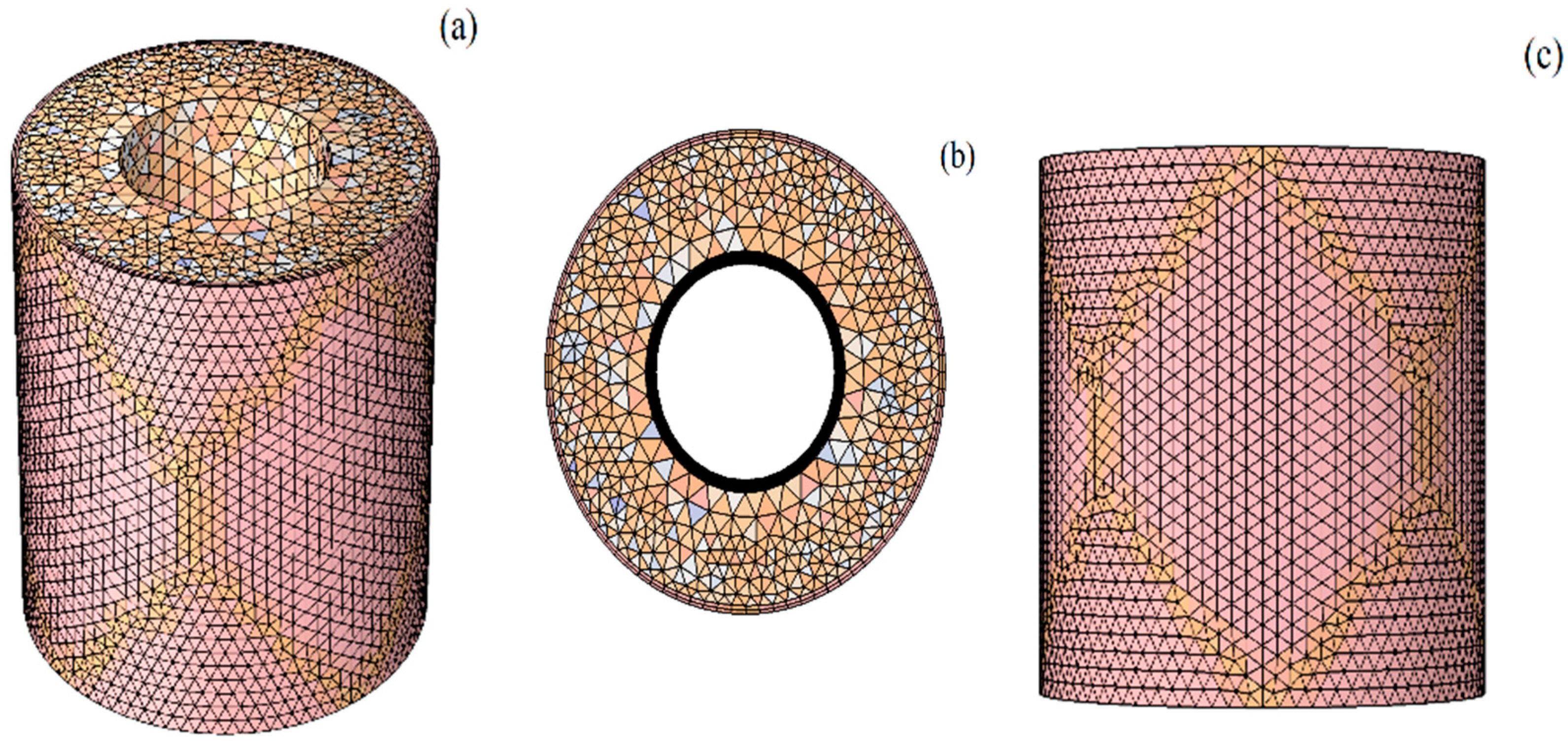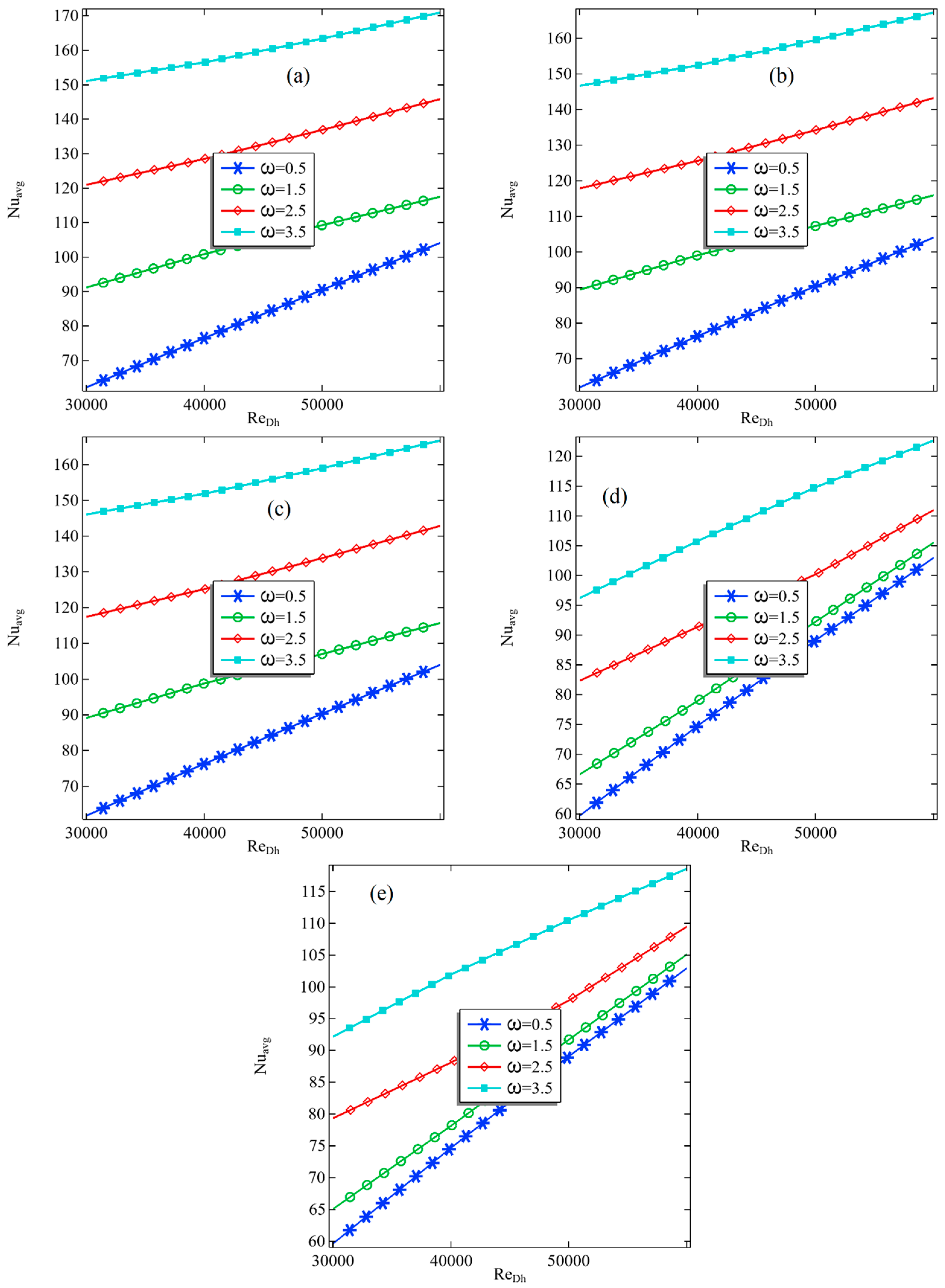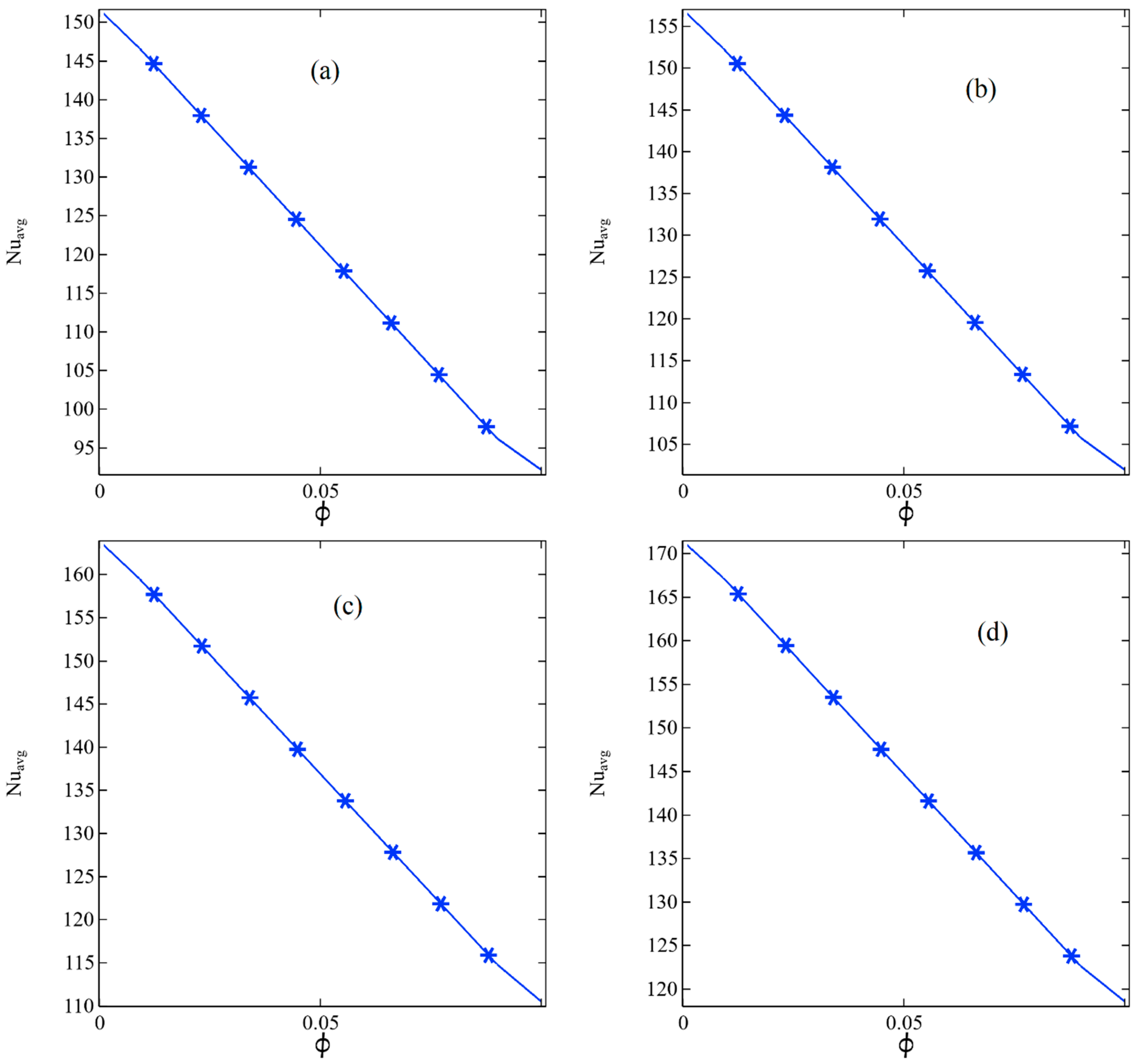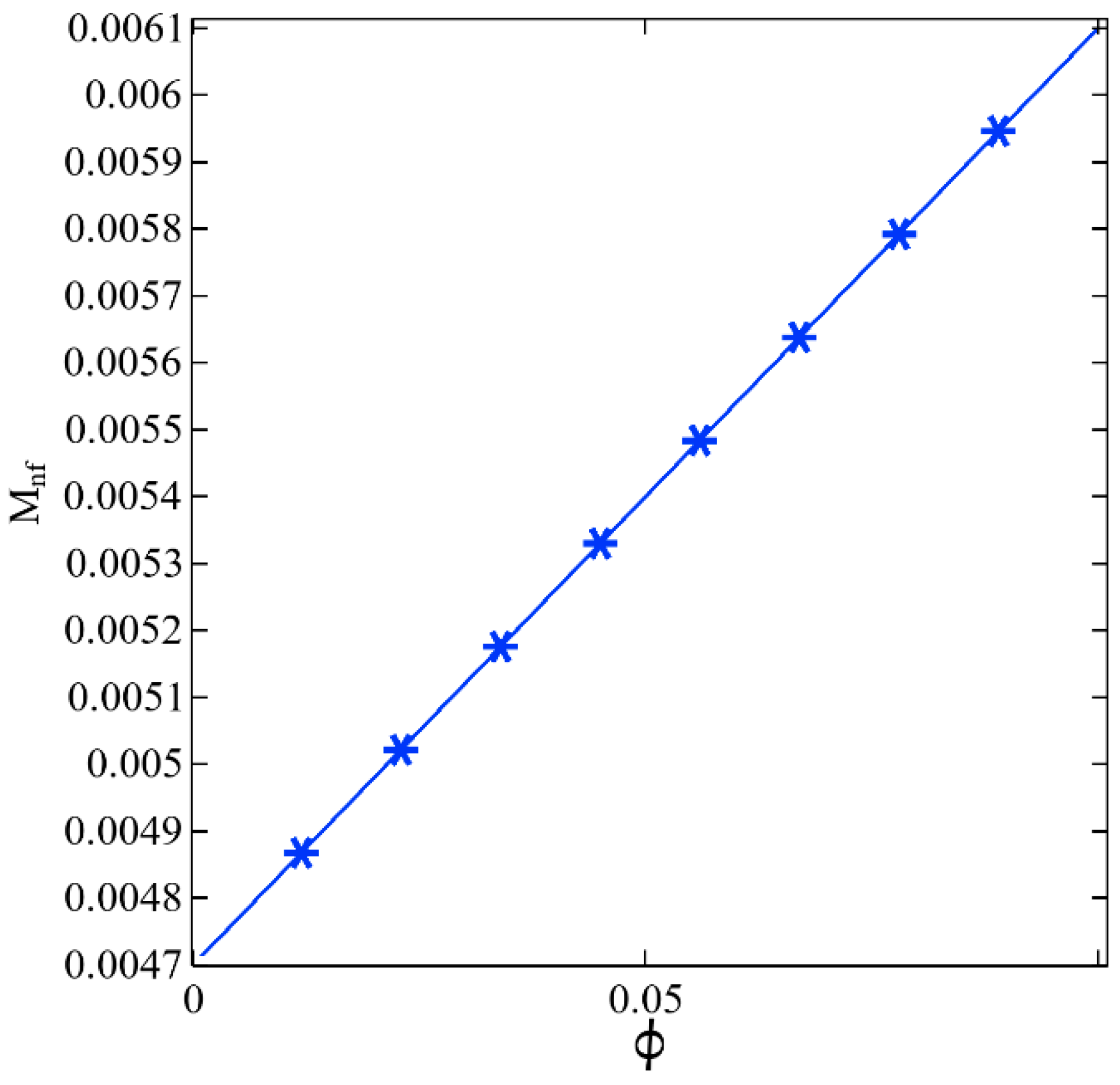The Forced Convection Analysis of Water Alumina Nanofluid Flow through a 3D Annulus with Rotating Cylinders via
Abstract
:1. Introduction
2. Problem Formulation, Boundary Condition, and Thermo-Physical Properties
- Continuity equation:
- Momentum equation:
- turbulence model:where
- Boundary conditions:
- Turbulence variable:
- Computational Parameters:
- ⮚
- Grashof number:
- ⮚
- Prandtl number:
- ⮚
- Heat flux:
- ⮚
- Heat transfer coefficient:
- ⮚
- Bulk temperature:
- ⮚
- Local Nusselt number along the ith direction:
- ⮚
- Average Nusselt number:
- ⮚
- Rayleigh number:
- COMSOL Workflow:
- Step 1:
- To make the observed channel and material used in the channel, we will first select the parameters;
- Step 2:
- Develop geometry using the tools of COMSOL Multiphysics 5.6;
- Step 3:
- Apply the boundary conditions by selecting the premises of the selected channel;
- Step 4:
- Perform the grid or mesh independency test to achieve high accuracy;
- Step 5:
- Validate or compare the results with the available results or experimental correlations;
- Step 6:
- Compute the numerical results by post-processing.
3. Mesh Independent Study and Validation
4. Results Discussion
4.1. Average Nusselt Number at the Exit of the Channel
4.2. Average Nusselt Number, Volume Fraction, and the Correlations
4.3. Mass Flow Rate and the Average Temperature on the Outer Cylinder
5. Conclusions
- ⮚
- The average Nusselt number at the exit of the channel is increased in a linear pattern against the increasing Reynolds number when the rotation of the inner and outer cylinders is fixed. Moreover, by increasing the rotation of the cylinders, the same behavior can be seen between the average Nusselt number and the Reynolds number, but the increment rate is gradually increased.
- ⮚
- From the tables, it is apparent that by fixing the Reynolds number and volume fraction, the average Nusselt number at the exit of the channel is increased by increasing the rotation of the circular cylinders. By fixing both the Reynolds number and the rotation of the circular cylinder, the average Nusselt number is reduced by increasing the volume fraction.
- ⮚
- The average Nusselt number in the middle of the channel decreases linearly with the increased volume fraction for the fixed rotation rate and the Reynolds number. Therefore, we determined several correlations by applying a linear regression process. These linear regression equations can be used for future predictions based on the conditions.
- ⮚
- The mass of the nanofluid entering the region was determined based on the computational results. The mass increased linearly with the increase in volume fraction. Moreover, a linear regression was given between the mass and volume fraction of the nanofluid.
- ⮚
- The average temperature against the mass flow rate decreased under certain limitations. Two critical values were found for the mass flow rate where the average temperature increases or decreases. Therefore, we suggest that this increment or decrement could be controlled by using the Reynolds number or the rotation of the inner cylinder, or both.
Author Contributions
Funding
Informed Consent Statement
Data Availability Statement
Conflicts of Interest
Future Work
References
- Maxwell, J.C. A Treatise on Electricity and Magnetism; Clarendon Press: Oxford, UK, 1873; Volume 1. [Google Scholar]
- Choi, S.U.; Eastman, J.A. Enhancing Thermal Conductivity of Fluids with Nanoparticles; No. ANL/MSD/CP-84938; CONF-951135-29; Argonne National Lab (ANL): Argonne, IL, USA, 1995. [Google Scholar]
- Lee, S.; Choi, S.S.; Li, S.A.; Eastman, J.A. Measuring thermal conductivity of fluids containing oxide nanoparticles. J. Heat Transfer. 1999, 121, 280–289. [Google Scholar] [CrossRef]
- Masuda, H.; Ebata, A.; Teramae, K. Alteration of thermal conductivity and viscosity of liquid by dispersing ultra-fine particles. Dispersion of Al2O3, SiO2 and TiO2 ultra-fine particles. Netsu Bussei 1993, 7, 227–233. [Google Scholar] [CrossRef]
- Xuan, Y.; Li, Q. Heat transfer enhancement of nanofluids. Int. J. Heat Fluid Flow 2000, 21, 58–64. [Google Scholar] [CrossRef]
- Xuan, Y.; Roetzel, W. Conceptions for heat transfer correlation of nanofluids. Int. J. Heat Mass Transf. 2000, 43, 3701–3707. [Google Scholar] [CrossRef]
- Keblinski, P.; Phillpot, S.R.; Choi, S.U.S.; Eastman, J.A. Mechanisms of heat flow in suspensions of nano-sized particles (nanofluids). Int. J. Heat Mass Transf. 2002, 45, 855–863. [Google Scholar] [CrossRef]
- Wang, X.; Xu, X.; Choi, S.U. Thermal conductivity of nanoparticle-fluid mixture. J. Thermophys. Heat Transf. 1999, 13, 474–480. [Google Scholar] [CrossRef]
- Choi, S.U.S.; Zhang, Z.G.; Yu, W.; Lockwood, F.E.; Grulke, E.A. Anomalous thermal conductivity enhancement in nanotube suspensions. Appl. Phys. Lett. 2001, 79, 2252–2254. [Google Scholar] [CrossRef]
- Zhang, X.; Gu, H.; Fujii, M. Effective thermal conductivity and thermal diffusivity of nanofluids containing spherical and cylindrical nanoparticles. J. Appl. Phys. 2006, 100, 044325. [Google Scholar] [CrossRef]
- Xue, Q.Z. Model for effective thermal conductivity of nanofluids. Phys. Lett. A 2003, 307, 313–317. [Google Scholar] [CrossRef]
- Xuan, Y.; Li, Q.; Hu, W. Aggregation structure and thermal conductivity of nanofluids. AIChE J. 2003, 49, 1038–1043. [Google Scholar] [CrossRef]
- Jang, S.P.; Choi, S.U. Role of Brownian motion in the enhanced thermal conductivity of nanofluids. Appl. Phys. Lett. 2004, 84, 4316–4318. [Google Scholar] [CrossRef]
- Chon, C.H.; Kihm, K.D.; Lee, S.P.; Choi, S.U. Empirical correlation finding the role of temperature and particle size for nanofluid (Al 2 O 3) thermal conductivity enhancement. Appl. Phys. Lett. 2005, 87, 153107. [Google Scholar] [CrossRef]
- Izadi, M.; Behzadmehr, A.; Jalali-Vahida, D. Numerical study of developing laminar forced convection of a nanofluid in an annulus. Int. J. Therm. Sci. 2009, 48, 2119–2129. [Google Scholar] [CrossRef]
- Li, C.H.; Peterson, G.P. The effect of particle size on the effective thermal conductivity of Al2O3-water nanofluids. J. Appl. Phys. 2007, 101, 044312. [Google Scholar] [CrossRef]
- Mintsa, H.A.; Roy, G.; Nguyen, C.T.; Doucet, D. New temperature dependent thermal conductivity data for water-based nanofluids. Int. J. Therm. Sci. 2009, 48, 363–371. [Google Scholar] [CrossRef]
- Pak, B.C.; Cho, Y.I. Hydrodynamic and heat transfer study of dispersed fluids with submicron metallic oxide particles. Exp. Heat Transf. Int. J. 1998, 11, 151–170. [Google Scholar] [CrossRef]
- Xuan, Y.; Li, Q. Investigation on convective heat transfer and flow features of nanofluids. J. Heat Transf. 2003, 125, 151–155. [Google Scholar] [CrossRef]
- Yu, W.; France, D.M.; Timofeeva, E.V.; Singh, D.; Routbort, J.L. Comparative review of turbulent heat transfer of nanofluids. Int. J. Heat Mass Transf. 2012, 55, 5380–5396. [Google Scholar] [CrossRef]
- Li, J.; Kleinstreuer, C. Thermal performance of nanofluid flow in microchannels. Int. J. Heat Fluid Flow 2008, 29, 1221–1232. [Google Scholar] [CrossRef]
- Santra, A.K.; Chakraborty, N.; Sen, S. Prediction of heat transfer due to presence of copper–water nanofluid using resilient-propagation neural network. Int. J. Therm. Sci. 2009, 48, 1311–1318. [Google Scholar] [CrossRef]
- Mirmasoumi, S.; Behzadmehr, A. Effect of nanoparticles mean diameter on mixed convection heat transfer of a nanofluid in a horizontal tube. Int. J. Heat Fluid Flow 2008, 29, 557–566. [Google Scholar] [CrossRef]
- Agwu Nnanna, A.G.; Rutherford, W.; Elomar, W.; Sankowski, B. January. Assessment of thermoelectric module with nanofluid heat exchanger. In Proceedings of the ASME International Mechanical Engineering Congress and Exposition, Washington, DC, USA, 11–15 November 2007; Volume 43025, pp. 663–672. [Google Scholar]
- Nguyen, C.T.; Roy, G.; Gauthier, C.; Galanis, N. Heat transfer enhancement using Al2O3—Water nanofluid for an electronic liquid cooling system. Appl. Therm. Eng. 2007, 27, 1501–1506. [Google Scholar] [CrossRef]
- Khanafer, K.; Vafai, K.; Lightstone, M. Buoyancy-driven heat transfer enhancement in a two-dimensional enclosure utilizing nanofluids. Int. J. Heat Mass Transf. 2003, 46, 3639–3653. [Google Scholar] [CrossRef]
- Koo, J.; Kleinstreuer, C. Laminar nanofluid flow in microheat-sinks. Int. J. Heat Mass Transf. 2005, 48, 2652–2661. [Google Scholar] [CrossRef]
- Akbari, M.; Behzadmehr, A.; Shahraki, F. Fully developed mixed convection in horizontal and inclined tubes with uniform heat flux using nanofluid. Int. J. Heat Fluid Flow 2008, 29, 545–556. [Google Scholar] [CrossRef]
- Mirmasoumi, S.; Behzadmehr, A. Numerical study of laminar mixed convection of a nanofluid in a horizontal tube using two-phase mixture model. Appl. Therm. Eng. 2008, 28, 717–727. [Google Scholar] [CrossRef]
- Ding, Y.; Wen, D. Particle migration in a flow of nanoparticle suspensions. Powder Technol. 2005, 149, 84–92. [Google Scholar] [CrossRef]
- Ali, L.; Ali, B.; Liu, X.; Iqbal, T.; Zulqarnain, R.M.; Javid, M. A comparative study of unsteady MHD Falkner–Skan wedge flow for non-Newtonian nanofluids considering thermal radiation and activation energy. Chin. J. Phys. 2022, 77, 1625–1638. [Google Scholar] [CrossRef]
- Ali, L.; Ali, B.; Ghori, M.B. Melting effect on Cattaneo–Christov and thermal radiation features for aligned MHD nanofluid flow comprising microorganisms to leading edge: FEM approach. Comput. Math. Appl. 2022, 109, 260–269. [Google Scholar] [CrossRef]
- Ali, L.; Liu, X.; Ali, B.; Mujeed, S.; Abdal, S.; Khan, S.A. Analysis of magnetic properties of nanoparticles due to a magnetic dipole in micropolar fluid flow over a stretching sheet. Coatings 2020, 10, 170. [Google Scholar] [CrossRef] [Green Version]
- Ali, B.; Naqvi, R.A.; Ali, L.; Abdal, S.; Hussain, S. A comparative description on time-dependent rotating magnetic transport of a water base liquid H2O with hybrid nanomaterials Al2O3-Cu and Al2O3-TiO2 over an extending sheet using Buongiorno model: Finite element approach. Chin. J. Phys. 2021, 70, 125–139. [Google Scholar] [CrossRef]
- Srivastava, N.C.; Bakhtar, F.; Bannister, F.K. An investigation into thermal boundary layer growth in the entrance region of an annulus. Int. J. Heat Mass Transf. 1973, 16, 49–59. [Google Scholar] [CrossRef]
- Gupta, S.C.; Garg, V.K. Developing flow in a concentric annulus. Comput. Methods Appl. Mech. Eng. 1981, 28, 27–35. [Google Scholar] [CrossRef]
- Lu, G.; Wang, J. Experimental investigation on heat transfer characteristics of water flow in a narrow annulus. Appl. Therm. Eng. 2008, 28, 8–13. [Google Scholar] [CrossRef]
- Selimefendigil, F.; Öztop, H.F. Mixed convection of nanofluids in a three dimensional cavity with two adiabatic inner rotating cylinders. Int. J. Heat Mass Transf. 2018, 117, 331–343. [Google Scholar] [CrossRef]
- Maxwell-Garnett, J.C. Colours in metal glasses and in metallic films. Philos. Trans. R. Soc. A 1904, 203, 385–420. [Google Scholar]
- Hazeri-Mahmel, N.; Shekari, Y.; Tayebi, A. Three-dimensional analysis of forced convection of Newtonian and non-Newtonian nanofluids through a horizontal pipe using single-and two-phase models. Int. Commun. Heat Mass Transf. 2021, 121, 105119. [Google Scholar] [CrossRef]
- Dittus, F.W.; Boelter, L.M.K. Heat transfer in automobile radiators of the tubular type. Int. Commun. Heat Mass Transf. 1985, 12, 3–22. [Google Scholar] [CrossRef]
- Sieder, E.N.; Tate, G.E. Heat transfer and pressure drop of liquids in tubes. Ind. Eng. Chem. 1936, 28, 1429–1435. [Google Scholar] [CrossRef]
- Li, Q.; Xuan, Y. Convective heat transfer and flow characteristics of Cu-water nanofluid. Sci. China Ser. E Technol. Sci. 2002, 45, 408–416. [Google Scholar]
- Taler, D.; Taler, J. Simple heat transfer correlations for turbulent tube flow. In E3S Web of Conferences; EDP Sciences: Paris, France, 2017; Volume 13, p. 02008. [Google Scholar]
- Available online: https://keisan.casio.com/exec/system/14059929550941 (accessed on 12 July 2022).








| Description | Property Name | Value/Range |
|---|---|---|
| Density of water | 997.1 [kg/m3] | |
| Density of aluminum oxide | 3970 [kg/m3] | |
| Heat capacity of water at constant pressure | 4179 [J/(mol K)] | |
| Heat capacity of aluminum oxide | 765 [J/(mol K)] | |
| Thermal conductivity of water | 0.613 [W/(m K)] | |
| Thermal conductivity of alumina | 40 [W/(m K)] | |
| Thermal expansion of water | 21 × 10−5 [1/K] | |
| Thermal expansion of water | 0.85 × 10−5 [1/K] | |
| Volume fraction | 0.001, 0.01, 0.1, 0.2 | |
| Density of nanofluid | ||
| Viscosity of water | 0.00081 [Pa s] | |
| Dynamic viscosity of nanofluid [8] | ||
| Acceleration due gravity | g | 9.8 m/s2 |
| Thermal expansion of the nanofluids | ||
| Thermal conductivity of nanofluid Maxwell Garnet model [39] | ||
| Heat capacitance of fluid | ||
| Heat capacitance of solid | ||
| Heat capacitance of nanofluid | ||
| Thermal diffusivity of nanofluid | ||
| Reference temperature of the square cavity | 293.15 [K] | |
| Hydraulic diameter | 4 Area of the channel/Perimeter | |
| Inlet velocity | ||
| Reynolds number | Re | 35,000 |
| Radius of cylinder | Ar | 0.4, 0.5, 0.6 |
| 1.44 | 1.92 | 0.09 | 1 | 1.3 |
| Re | Present Work | Dittus and Boelter [41] | Sieder and Tate [42] | Li and Xuan [43] | Dawid and Jan [44] |
|---|---|---|---|---|---|
| 3 × 104 | 81.606 | 83.272 | 97.754 | 75.736 | 74.886 |
| 4 × 104 | 102.674 | 104.770 | 122.990 | 98.734 | 94.216 |
| 5 × 104 | 122.712 | 125.217 | 146.994 | 121.303 | 112.620 |
| 6 × 104 | 141.964 | 144.861 | 170.055 | 143.533 | 130.312 |
| Re | ||||||||
|---|---|---|---|---|---|---|---|---|
| 30,000 | 0.001 | 62.17 | 91.16 | 46.63 | 120.93 | 32.66 | 151.06 | 24.92 |
| 30,000 | 0.009 | 61.90 | 89.36 | 44.37 | 117.83 | 31.86 | 146.66 | 24.47 |
| 30,000 | 0.01 | 61.86 | 89.11 | 44.04 | 117.39 | 31.74 | 146.04 | 24.41 |
| 30,000 | 0.09 | 59.72 | 66.60 | 11.52 | 82.33 | 23.61 | 96.20 | 16.85 |
| 30,000 | 0.1 | 59.60 | 65.05 | 9.13 | 79.32 | 21.95 | 92.14 | 16.15 |
| 40,000 | 0.001 | 76.47 | 100.84 | 31.87 | 128.44 | 27.37 | 156.46 | 21.82 |
| 40,000 | 0.009 | 76.30 | 99.02 | 29.78 | 125.56 | 26.80 | 152.39 | 21.37 |
| 40,000 | 0.01 | 76.28 | 98.76 | 29.48 | 125.15 | 26.72 | 151.82 | 21.31 |
| 40,000 | 0.09 | 74.75 | 78.93 | 5.59 | 91.35 | 15.74 | 105.76 | 15.77 |
| 40,000 | 0.1 | 74.66 | 78.12 | 4.63 | 88.06 | 12.73 | 101.91 | 15.72 |
| 50,000 | 0.001 | 90.48 | 109.23 | 20.72 | 136.86 | 25.30 | 163.36 | 19.36 |
| 50,000 | 0.009 | 90.34 | 107.26 | 18.72 | 134.18 | 25.10 | 159.50 | 18.87 |
| 50,000 | 0.01 | 90.33 | 106.99 | 18.45 | 133.81 | 25.07 | 158.96 | 18.80 |
| 50,000 | 0.09 | 89.11 | 92.23 | 3.49 | 100.16 | 8.60 | 114.79 | 14.61 |
| 50,000 | 0.1 | 89.05 | 91.68 | 2.96 | 97.83 | 6.71 | 110.48 | 12.93 |
| 60,000 | 0.001 | 104.08 | 117.46 | 12.86 | 145.80 | 24.13 | 170.92 | 17.23 |
| 60,000 | 0.009 | 103.97 | 115.86 | 11.44 | 143.18 | 23.58 | 167.24 | 16.80 |
| 60,000 | 0.01 | 103.95 | 115.65 | 11.26 | 142.81 | 23.48 | 166.72 | 16.74 |
| 60,000 | 0.09 | 102.95 | 105.49 | 2.47 | 110.94 | 5.17 | 122.63 | 10.54 |
| 60,000 | 0.1 | 102.90 | 105.06 | 2.10 | 109.42 | 4.15 | 118.55 | 8.34 |
| Correlations | Conditions |
|---|---|
| = 0.5, Re = 30,000 | |
| = 0.5, Re = 40,000 | |
| = 0.5, Re = 50,000 | |
| = 0.5, Re = 60,000 | |
| = 1.5, Re = 30,000 | |
| = 1.5, Re = 40,000 | |
| = 1.5, Re = 50,000 | |
| = 1.5, Re = 60,000 | |
| = 2.5, Re = 30,000 | |
| = 2.5, Re = 40,000 | |
| = 2.5, Re = 50,000 | |
| = 2.5, Re = 60,000 | |
| = 3.5, Re = 30,000 | |
| = 3.5, Re = 40,000 | |
| = 3.5, Re = 50,000 | |
| = 3.5, Re = 60,000 |
Publisher’s Note: MDPI stays neutral with regard to jurisdictional claims in published maps and institutional affiliations. |
© 2022 by the authors. Licensee MDPI, Basel, Switzerland. This article is an open access article distributed under the terms and conditions of the Creative Commons Attribution (CC BY) license (https://creativecommons.org/licenses/by/4.0/).
Share and Cite
Alqarni, M.S.; Memon, A.A.; Anwaar, H.; Usman; Muhammad, T.
The Forced Convection Analysis of Water Alumina Nanofluid Flow through a 3D Annulus with Rotating Cylinders via
Alqarni MS, Memon AA, Anwaar H, Usman, Muhammad T.
The Forced Convection Analysis of Water Alumina Nanofluid Flow through a 3D Annulus with Rotating Cylinders via
Alqarni, Marei Saeed, Abid Ali Memon, Haris Anwaar, Usman, and Taseer Muhammad.
2022. "The Forced Convection Analysis of Water Alumina Nanofluid Flow through a 3D Annulus with Rotating Cylinders via






